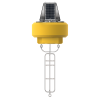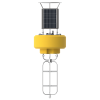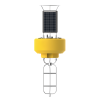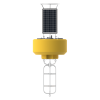Garmin GPS 24xd HVS Marine GNSS Receiver
Features
- Provides access to GPS, Galileo, GLONASS and BeiDou satellite systems
- Accurate to <1 meter CEP, <3 meters 95%
- IPX7 waterproof sensor with pole and flush mount options
- Free ground shipping
- Expedited repair and warranty service
- Lifetime technical support
- More
GPS 24xd HVS
The highly accurate GPS 24xd HVS position receiver/antenna provides up to 10 Hz update rates for position, velocity and time data. It offers high-sensitivity reception and enhanced position acquisition to the Garmin family of marine instruments, autopilots and multifunction displays.
Delivers Precise Location Data
This receiver is capable of tracking multiple global navigation satellite systems, including GPS, Galileo, GLONASS and BeiDou. Since more satellites are visible, it can provide more accurate fixes in challenging conditions. WAAS-capable, it can determine precise location to within <1 meter CEP, <3 meters 95%.
Observable Advantages
Compared to units with slower update rates, the GPS 24xd offers dramatic improvement when used at low speeds. Position and course information from slower units can jitter and swing considerably at speeds below 1 mph. The GPS 24xd provides a consistent and smooth heading which is especially important when trying to hit a specific waypoint or mark.
Built for Versatility
Part of the Garmin marine instrument family, the GPS 24xd HVS is built to withstand the elements. This waterproof (IPX7) sensor can be pole mounted or flush mounted. It also can be attached to the underside of many fiberglass decks for added ease of installation. In addition, it also can be configured to have 1 Hz or 5 Hz update rates to help support specific installation requirements.
- Dimensions (D x H): 3 19/32" x 1 15/16" (91.6 mm x 49.5 mm)
- Weight: 7.1 oz (201 g)
- Cable length: 30 ft (9.14 m)
- Temperature range: -22° to 176° F (-30° to 80° C)
- Case material: Fully gasketed, high-impact plastic alloy; waterproof to IPX7
- Compass-safe distance: .5" (12.7 mm)
- Power source input: 8-32V, unregulated
- Input current: 150 mA at 12 Vdc
- Position accuracy, typical marine use: < 50 cm, CEP 50%; < 1.0 meter, 88%
- GPS 24xd HVS
- Pole mount
- Surface mount
- Under deck mount
- Power/data cable
- Update rate select cable
- Documentation
In The News
Spring 2025 Environmental Monitor Available Now
In the Spring 2025 edition of the Environmental Monitor, we highlight partnerships across the world and the importance of collaboration between government agencies, universities, environmental groups, local communities, and other stakeholders. From great white shark research in Cape Cod to monitoring fisheries in Lake Erie, this latest edition underscores partnerships that connect stakeholders in a watershed through environmental data. With an emphasis on data sharing, a combination of real-time and discrete sampling keeps the public and partners informed of environmental conditions. Our writers also sought out science professionals dedicated to working with peers within and outside of the environmental sector.
Read MoreMonitoring Mariculture in the Gulf of Alaska
The mariculture industry in the Gulf of Alaska has been steadily growing in recent years, guided by ongoing research to help refine farm location and cultivation practices. A subset of aquaculture, mariculture focuses on rearing organisms in the open ocean. In Alaska, finfish farming is illegal, so most farms cultivate kelp, oysters, or a combination of the two. These small, locally operated farms started popping up in the Gulf of Alaska in the early 1990s, when shellfish farming first became legal. Kelp farming did not begin to catch on in the state until 2016. Many of the coastal areas that have grown interested in mariculture are historically commercial fishing communities.
Read MoreSupplying Seattle’s Drinking Water: Using Data Buoys to Monitor the Cedar River Municipal Watershed
Providing clean, safe, and reliable drinking water for the 1.6 million people in the greater Seattle area is a top priority for Seattle Public Utilities (SPU). With limited water supplies, SPU dedicates considerable resources to maintain its watersheds and mountain reservoirs. About 70 percent of Seattle Water comes from the Cedar River Municipal Watershed , and the other 30 percent comes from the South Fork Tolt River Watershed . [caption id="attachment_39574" align="alignnone" width="940"] Data buoy in Chester Morse Lake . (Credit: Kevin Johnson / Seattle Public Utilities) [/caption] Jamie Thompson, a fisheries biologist at SPU, monitors aquatic ecosystems centered on fish listed under the U.S. Endangered Species Act (ESA).
Read More















